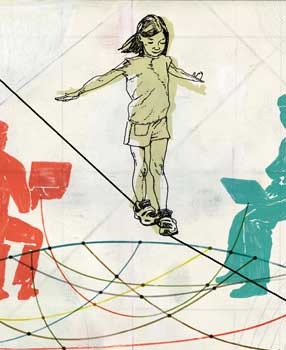FALL 2008 CONTENTS
Home
Prognosis: uncertain
Overhauling the health-care system
SOS NIH
A wake-up call to all who care about science—or for that matter, prosperity
California dreamin’
The Golden State’s golden opportunity
The real issues in health-care reform
Beyond the rhetoric
Bread, butter, and universal health care
Safeway’s CEO talks reform
Armies of the status quo
The Washington health-care lobby
Back to back: Gingrich and Wyden
A Republican and a Democrat weigh in on health-care reform
An open letter to the new president
Science matters
NETworking
Fighting for children’s health inside the hospital and out


NETworking
Fighting for children’s health inside the hospital and out
By Krista Conger
Illustration by Jeffrey Decoster
Pediatric residents are among the hardest-working people around. But some are convinced that their 80 hours of caring each week just aren’t enough. They’re increasingly aware that their young patients’ health is influenced by what happens outside the hospital. And they don’t like what they see.
Pediatric health care is under fire on all fronts, from the hotly contested presidential veto of a bill to extend and expand the State Children’s Health Insurance Program, or SCHIP, last year, to a proposal in California that would make Medicaid enrollment more onerous, to cuts in funds devoted to training new pediatricians.
“Pediatric residents around the country are seeing firsthand the negative effects of these legislative decisions on kids’ health care,” says assistant professor of pediatrics and residency advocacy training expert Lisa Chamberlain, MD. “They are passionate about helping these children.”
Passionate only begins to describe Packard Children’s Hospital pediatric resident and budding politician Arti Desai, MD. After last year’s fight for SCHIP, she hit on the idea of using social networking as an effective way to organize pediatric residents around the country interested in advocating for their young patients. She’d had plenty of experience.
“I’m on everything,” she says with an engaging smile. “Facebook, Friendster, MySpace….” Like her peers, Desai’s equally at home on the Internet as in the halls of Lucile Packard Children’s Hospital, and she’s built an online meeting place on ning.com where like-minded pediatricians-in-training can learn about current legislative happenings, download media kits and letter-writing templates and access complete, presentation-ready materials to share with others at their institutions. Desai hopes the social network, REACH, gives her peers an easy way to look up from their grindstones and get involved in issues they really care about in the upcoming election — a unique idea whose time has come.
“Arti’s notion of reaching out to and banding together with other pediatric residents sounds simple, but to my knowledge nothing like this has been done before,” says Packard Children’s pediatrician Charles Prober, MD, Stanford’s senior associate dean for medical student education. “There aren’t any good, established channels of communication for pediatric residents at different institutions.”
The REACH residents — who represent more than 20 institutions around the country — are also gathering personal stories about how real kids and their families are affected by health-care policy, and compiling a 2008 voter guide that will highlight candidates’ records and rhetoric with regard to children’s health. Will they make a difference?
“It’s very clear that legislators like to have information from people who are close to the issues” says Prober, himself a seasoned advocate for children. “Pediatric residents, who sit at the bedsides of patients with their families, see and feel the problems at the most intimate levels.”
Perhaps most important, though, these future physicians are teaching themselves how to be powerful advocates for children — a lesson that will last a lifetime and will likely echo for decades in America’s legislative hallways. Pediatric residents become pediatricians, who become academic and institutional leaders and (dare we say it?) perhaps even politicians.
“They are the lifeblood of our profession,” says Prober, “and the level of energy and engagement in these issues I’ve seen in the past couple of years is unprecedented. It’s very moving, and very exciting.”
Desai puts it more bluntly: “We’re working 80 hours a week. If I’m spending this much time in the hospital to care for these kids, I want to know that other issues outside the hospital will be taken care of.”

